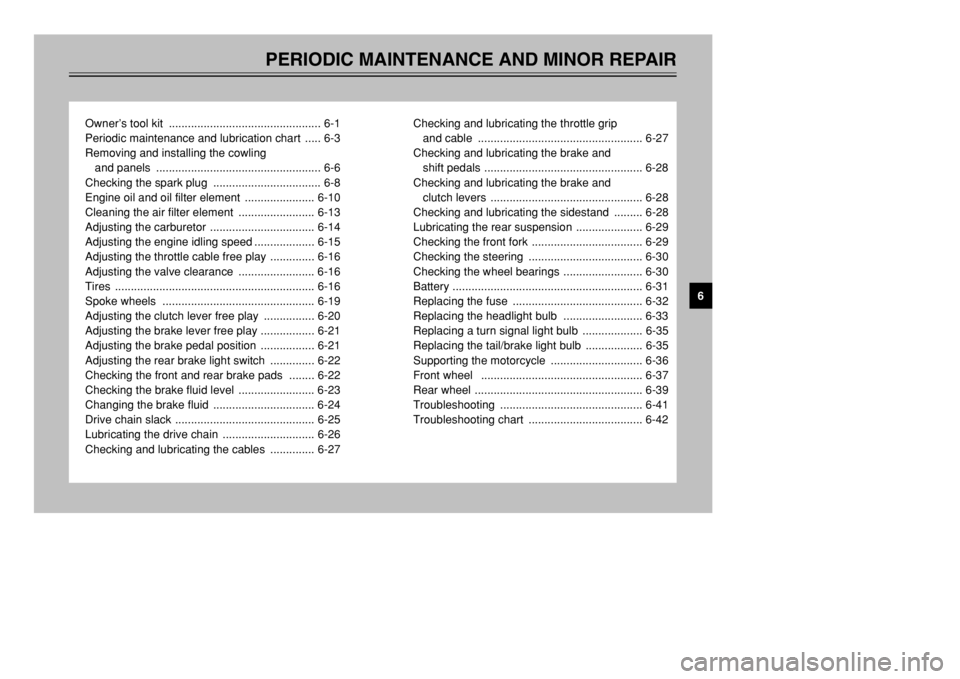engine YAMAHA XT500E 2002 User Guide
[x] Cancel search | Manufacturer: YAMAHA, Model Year: 2002, Model line: XT500E, Model: YAMAHA XT500E 2002Pages: 100, PDF Size: 2.1 MB
Page 27 of 100

3-13
INSTRUMENT AND CONTROL FUNCTIONS
3
With the engine turned off:
1. Move the sidestand down.
2. Make sure that the engine stop switch is set to “
#”.
3. Turn the key to “ON”.
4. Shift the transmission into the neutral position.
5. Push the start switch.
Does the engine start?
The neutral switch may be defective.
The motorcycle should not be ridden until
checked by a Yamaha dealer.
With the engine still running:
6. Move the sidestand up.
7. Keep the clutch lever pulled.
8. Shift the transmission into gear.
9. Move the sidestand down.
Does the engine stall?After the engine has stalled:
10. Move the sidestand up.
11. Keep the clutch lever pulled.
12. Push the start switch.
Does the engine start?
The sidestand switch may be defective.
The motorcycle should not be ridden until
checked by a Yamaha dealer.The clutch switch may be defective.
The motorcycle should not be ridden until
checked by a Yamaha dealer.
NO
NOTE:This check is most reliable if performed with
a warmed-up engine.
YESYES NO
The system is OK. The motorcycle can be ridden.
YES NO
4PT-E7 (English) 6/29/01 9:13 AM Page 26
Page 29 of 100

4-1
EAU01114
PRE-OPERATION CHECKS
4The condition of a vehicle is the owner’s responsibility. Vital components can start to deteriorate quickly and unexpect-
edly, even if the vehicle remains unused (for example, as a result of exposure to the elements). Any damage, fluid leak-
age or loss of tire air pressure could have serious consequences. Therefore, it is very important, in addition to a thor-
ough visual inspection, to check the following points before each ride.
EAU03439
Pre-operation check list
Pre-operation check list
ITEM CHECKS PAGE
Fuel•Check fuel level in fuel tank.
•Refuel if necessary.
•Check fuel line for leakage.3-6–3-7
Engine oil•Check oil level in engine.
•If necessary, add recommended oil to specified level.
•Check vehicle for oil leakage.6-10–6-13
Front brake•Check operation.
•If soft or spongy, have Yamaha dealer bleed hydraulic system.
•Check lever free play.
•Adjust if necessary.
•Check fluid level in reservoir.
•If necessary, add recommended brake fluid to specified level.
•Check hydraulic system for leakage.3-5, 6-21–6-24
Rear brake•Check operation.
•If soft or spongy, have Yamaha dealer bleed hydraulic system.
•Check fluid level in reservoir.
•If necessary, add recommended brake fluid to specified level.
•Check hydraulic system for leakage.3-5, 6-21–6-24
4PT-E7 (English) 6/29/01 9:13 AM Page 28
Page 32 of 100

OPERATION AND IMPORTANT RIDING POINTS
Starting the engine ........................................................................... 5-1
Starting a warm engine ..................................................................... 5-2
Shifting .............................................................................................. 5-3
Recommended shift points (for Switzerland only) ............................ 5-3
Tips for reducing fuel consumption .................................................. 5-4
Engine break-in ................................................................................ 5-4
Parking ............................................................................................. 5-5
5
4PT-E7 (English) 6/29/01 9:13 AM Page 31
Page 33 of 100

1. Turn the fuel cock lever to “ON”.
2. Turn the key to “ON” and make
sure that the engine stop switch
is set to “#”.
3. Shift the transmission into the
neutral position.NOTE:
When the transmission is in the neu-
tral position, the neutral indicator light
should be on, otherwise have a
Yamaha dealer check the electrical
circuit.4. Turn the starter (choke) on and
completely close the throttle.
(See page 3-9 for starter (choke)
operation.)
5. Start the engine by pushing the
start switch.
5-1
EAU00372
OPERATION AND IMPORTANT RIDING POINTS
5
EAU00373
w8Become thoroughly familiar
with all operating controls and
their functions before riding.
Consult a Yamaha dealer
regarding any control or func-
tion that you do not thorough-
ly understand.
8Never start the engine or oper-
ate it in a closed area for any
length of time. Exhaust fumes
are poisonous, and inhaling
them can cause loss of con-
sciousness and death within a
short time. Always make sure
that there is adequate ventila-
tion.
8Before starting out, make sure
that the sidestand is up. If the
sidestand is not raised com-
pletely, it could contact the
ground and distract the opera-
tor, resulting in a possible loss
of control.
EAU03515
Starting the engineStarting the engineIn order for the ignition circuit cut-off
system to enable starting, one of the
following conditions must be met:
8The transmission is in the neutral
position.
8The transmission is in gear with
the clutch lever pulled and the
sidestand up.
EW000054
w8Before starting the engine,
check the function of the igni-
tion circuit cut-off system
according to the procedure
described on page 3-13.
8Never ride with the sidestand
down.
4PT-E7 (English) 6/29/01 9:13 AM Page 32
Page 34 of 100

5-2
OPERATION AND IMPORTANT RIDING POINTS
5 7. When the engine is warm, turn
the starter (choke) off.
NOTE:
The engine is warm when it responds
normally to the throttle with the starter
(choke) turned off.
EAU01258
Starting a warm engineEngine, starting a warmFollow the same procedure as for
starting a cold engine with the excep-
tion that the starter (choke) is not
required when the engine is warm.
NOTE:
If the engine fails to start, release the
start switch, wait a few seconds, and
then try again. Each starting attempt
should be as short as possible to pre-
serve the battery. Do not crank the
engine more than 10 seconds on any
one attempt.6. After starting the engine, move
the starter (choke) knob back
halfway.
ECA00055
cCFor maximum engine life, always
warm the engine up before starting
off. Never accelerate hard when
the engine is cold!
4PT-E7 (English) 6/29/01 9:13 AM Page 33
Page 35 of 100

5-3
OPERATION AND IMPORTANT RIDING POINTS
5
EAU00423
ShiftingShiftingShifting gears lets you control the
amount of engine power available for
starting off, accelerating, climbing
hills, etc.
The gear positions are shown in the
illustration.NOTE:
To shift the transmission into the neu-
tral position, press the shift pedal
down repeatedly until it reaches the
end of its travel, and then slightly
raise it.
EC000048
cC8Even with the transmission in
the neutral position, do not
coast for long periods of time
with the engine off, and do not
tow the motorcycle for long
distances. The transmission is
properly lubricated only when
the engine is running.
Inadequate lubrication may
damage the transmission.
8Always use the clutch while
changing gears to avoid dam-
aging the engine, transmis-
sion, and drive train, which are
not designed to withstand the
shock of forced shifting.
EAU02941
Recommended shift points
(for Switzerland only)Shift points (for Switzerland only)The recommended shift points during
acceleration are shown in the table
below.NOTE:
When shifting down two gears at a
time, reduce the speed accordingly
(e.g., down to 35 km/h when shifting
from 4th to 2nd gear).
1
5
4
3
2
N
1
1. Shift pedal
N. Neutral position
Shift point (km/h)
1st →2nd 23
2nd →3rd 36
3rd →4th 50
4th →5th 60
4PT-E7 (English) 6/29/01 9:13 AM Page 34
Page 36 of 100

5-4
OPERATION AND IMPORTANT RIDING POINTS
5
EAU00424
Tips for reducing fuel
consumptionFuel consumption, tips for reducingFuel consumption depends largely on
your riding style. Consider the follow-
ing tips to reduce fuel consumption:
8Thoroughly warm up the engine.
8Turn the starter (choke) off as
soon as possible.
8Shift up swiftly, and avoid high
engine speeds during accelera-
tion.
8Do not rev the engine while shift-
ing down, and avoid high engine
speeds with no load on the
engine.
8Turn the engine off instead of let-
ting it idle for an extended length
of time (e.g., in traffic jams, at
traffic lights or at railroad cross-
ings).
EAU01128
Engine break-inEngine break-inThere is never a more important peri-
od in the life of your engine than the
period between 0 and 1,600 km. For
this reason, you should read the fol-
lowing material carefully.
Since the engine is brand new, do
not put an excessive load on it for the
first 1,600 km. The various parts in
the engine wear and polish them-
selves to the correct operating clear-
ances. During this period, prolonged
full-throttle operation or any condition
that might result in engine overheat-
ing must be avoided.
EAU04315
0–1,000 km
Avoid prolonged operation above
4,000 r/min.
1,000–1,600 km
Avoid prolonged operation above
5,000 r/min.
ECA00058
cCAfter 1,000 km of operation, the
engine oil must be changed, and
the oil filter element replaced.1,600 km and beyond
The vehicle can now be operated
normally.
4PT-E7 (English) 6/29/01 9:13 AM Page 35
Page 37 of 100

5-5
OPERATION AND IMPORTANT RIDING POINTS
5
EC000053
cC8Keep the engine speed out of
the tachometer red zone.
8If any engine trouble should
occur during the engine break-
in period, immediately have a
Yamaha dealer check the vehi-
cle.
EAU00457
ParkingParkingWhen parking, stop the engine,
remove the key from the main switch,
and then turn the fuel cock lever to
“OFF”.
EW000058
w8Since the engine and exhaust
system can become very hot,
park in a place where pedestri-
ans or children are not likely
to touch them.
8Do not park on a slope or on
soft ground, otherwise the
motorcycle may overturn.
4PT-E7 (English) 6/29/01 9:13 AM Page 36
Page 38 of 100

PERIODIC MAINTENANCE AND MINOR REPAIR
Owner’s tool kit ................................................ 6-1
Periodic maintenance and lubrication chart ..... 6-3
Removing and installing the cowling
and panels .................................................... 6-6
Checking the spark plug .................................. 6-8
Engine oil and oil filter element ...................... 6-10
Cleaning the air filter element ........................ 6-13
Adjusting the carburetor ................................. 6-14
Adjusting the engine idling speed ................... 6-15
Adjusting the throttle cable free play .............. 6-16
Adjusting the valve clearance ........................ 6-16
Tires ............................................................... 6-16
Spoke wheels ................................................ 6-19
Adjusting the clutch lever free play ................ 6-20
Adjusting the brake lever free play ................. 6-21
Adjusting the brake pedal position ................. 6-21
Adjusting the rear brake light switch .............. 6-22
Checking the front and rear brake pads ........ 6-22
Checking the brake fluid level ........................ 6-23
Changing the brake fluid ................................ 6-24
Drive chain slack ............................................ 6-25
Lubricating the drive chain ............................. 6-26
Checking and lubricating the cables .............. 6-27Checking and lubricating the throttle grip
and cable .................................................... 6-27
Checking and lubricating the brake and
shift pedals .................................................. 6-28
Checking and lubricating the brake and
clutch levers ................................................ 6-28
Checking and lubricating the sidestand ......... 6-28
Lubricating the rear suspension ..................... 6-29
Checking the front fork ................................... 6-29
Checking the steering .................................... 6-30
Checking the wheel bearings ......................... 6-30
Battery ............................................................ 6-31
Replacing the fuse ......................................... 6-32
Replacing the headlight bulb ......................... 6-33
Replacing a turn signal light bulb ................... 6-35
Replacing the tail/brake light bulb .................. 6-35
Supporting the motorcycle ............................. 6-36
Front wheel ................................................... 6-37
Rear wheel ..................................................... 6-39
Troubleshooting ............................................. 6-41
Troubleshooting chart .................................... 6-42
6
4PT-E7 (English) 6/29/01 9:13 AM Page 37
Page 43 of 100

6-5
PERIODIC MAINTENANCE AND MINOR REPAIR
6
EAU03884
NOTE:
8The air filter needs more frequent service if you are riding in unusually wet or dusty areas.
8Hydraulic brake service
9Regularly check and, if necessary, correct the brake fluid level.
9Every two years replace the internal components of the brake master cylinders and calipers, and change the
brake fluid.
9Replace the brake hoses every four years and if cracked or damaged.20
*Rear suspension relay
arm and connecting arm
pivoting points•Check operation.√√√√
•Lubricate with molybdenum disulfide grease.√√
21*Carburetor•Check starter (choke) operation.
•Adjust engine idling speed.√√√√√ √
22 Engine oil•Change.
•Check oil level and vehicle for oil leakage.√√√√√ √
23 Engine oil filter element•Replace.√√√
24*Front and rear brake
switches•Check operation.√√√√√ √
25 Moving parts and cables•Lubricate.√√√√ √
26*Lights, signals and
switches•Check operation.
•Adjust headlight beam.√√√√√ √ NO. ITEM CHECK OR MAINTENANCE JOBODOMETER READING (× 1,000 km)
ANNUAL
CHECK
1 10203040
4PT-E7 (English) 6/29/01 9:13 AM Page 42